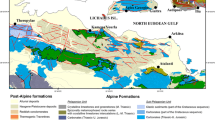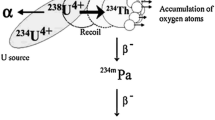Abstract
Hot springs from the Caldas Novas Thermal Complex have been used for balneological purposes since its discovery in the eighteenth century. A detailed analysis has been conducted to investigate the natural radioactivity of these waters due to dissolved 222Rn, 238U and 234U. Sampling campaigns occurred during the dry and rainy seasons to observe how these radioelements are affected by seasonality. Measurements included analyses of alpha-emitting radionuclides, physicochemical parameters and major constituents. Aside from quantitative results, significant correlations were obtained between 222Rn, dissolved oxygen, Eh and sodium, and between 238U, dissolved oxygen, pH, electrical conductivity and calcium. The 234U/238U activity ratio was used as an indirect prospecting tool to indicate whether or not there are potential uranium ore bodies currently forming in this area, and also to demonstrate how mixing of different groundwater masses is occurring.










Similar content being viewed by others
References
Connecticut Department of Public Health (DPH) (2012) Radon in your water. Environmental Health Section. Radon Program. Fact Sheet February 2012 https://sosradon.org/files/sosradon/resources/Connecticut%20Radon%20in%20Water.pdf Accessed 08 Nov 2022
World Health Organization (WHO) (2001) Depleted uranium: sources, exposure and health effects. Department of Protection of the Human Environment. Geneva April 2001 https://www.who.int/publications/i/item/WHO-SDE-PHE-01.1 Accessed 08 Nov 2022
Brazil (2011) Ministry of Health. Ordinance No. 2,914. Provides the procedures for controlling and monitoring the quality of water for human consumption and its potability standard. Brasília. Official Journal of the Union (DOU). 39–46. https://bvsms.saude.gov.br/bvs/saudelegis/gm/2011/prt2914_12_12_2011.html Accessed 01 Sep 2022
Brazil (1945) Code of Mineral Waters. Decree-Law No. 7.841 of August 8th 1945. https://www.camara.leg.br/proposicoesWeb/prop_mostrarintegra;jsessionid=C9B17DD08CE68890721582ECAFDBBDAD.proposicoesWebExterno2?codteor=439991&filename=LegislacaoCitada+-PL+282/2007 Accessed 14 Nov 2022
USEPA (United States Environmental Protection Agency) (2022) National Primary Drinking Water Regulations (NPDWR) https://www.epa.gov/sites/default/files/2016-06/documents/npwdr_complete_table.pdf Accessed 18 Jul 2022
USGS (United States Geological Survey) (1962) Data on uranium and radium in ground water in the United States, 1954 to 1957. Washington, U.S. Govt Print Off https://pubs.usgs.gov/pp/0426/report.pdf Accessed 18 Jul 2022
WHO (World Health Organization) (2017) Guidelines for drinking-water quality: 4th Edition incorporating the 1st addendum. https://www.who.int/publications/i/item/9789241549950 Accessed 18 Jul 2022
Catão RLCMR, Feitosa PHC, Rodrigues ACL, Barbosa DL, Guedes MTJC (2022) Maximum recommended and allowable radon-222 limits in water and air: systematic review. https://doi.org/10.21203/rs.3.rs-1280942/v1
USEPA (United States Environmental Protection Agency) (2014) Basic information about radon in drinking water. https://archive.epa.gov/water/archive/web/html/basicinformation-2.html Accessed 10 Nov 2022
Swistock B (2022) Reducing radon in drinking water. College of Agricultural Sciences. Pennsylvania State University https://extension.psu.edu/reducing-radon-in-drinkingwater#:~:text=Based%20on%20the%20potential%20for,but%20no%20standard%20currently%20exists. Accessed 10 Nov 2022
EU Commission Recommendation (2001), (2001/928/Euratom), Commission Recommendation of 20 December 2001 on the protection of the public against exposure to radon in drinking water supplies (notified under document number C(2001) 4580) OJ L 344, 28.12.2001, p. 85–88 https://eur-lex.europa.eu/eli/reco/2001/928/oj Accessed 08 Nov 2022
Gruber V, Ringer W (2017) Radon exposure at specific workplaces in Austria—experiences and future challenges. Radiat Prot Dosim 177:7–11
Godoy JM, Godoy ML (2006) Natural radioactivity in Brazilian groundwater. J Environ Radioact. https://doi.org/10.1016/j.jenvrad.2005.05.009
Campos EC, Costa JFG, Marques JDM (1980) Hydrogeological Study Project of the Caldas Nova Region, Goiás. https://rigeo.cprm.gov.br/xmlui/handle/doc/9259 Accessed 01 Sep 2022
Cook PG, Favreau G, Dighton JC, Tickell C (2003) Determining natural groundwater influx to a tropical river using radon, chlorofluorocarbons and ionic environmental tracers. J Hydrol. https://doi.org/10.1016/S0022-1694(03)00087-8
Fianco ACB (2011) Radon concentrations in groundwater, rocks and soils in Porto Alegre (RS). Master’s thesis. https://www.lume.ufrgs.br/bitstream/handle/10183/32667/000786610.pdf?sequence=1 Accessed 01 Sep 2022
Fleischer RL (1980) Isotopic disequilibrium of uranium: Alpha-recoil damage and preferential solution effects. Science 207(4434):979–981. https://doi.org/10.1126/science.207.4434.979
Skeppström K, Olofsson B (2007) Uranium and radon in groundwater: an overview of the problem. Eur Water 17(18):51–62
Tanner AB (1980) Radon migration in the ground: a supplementary review. Natural Radiation Environment III, Symp. Proc., US DOE, NTIS Report CONF-780422 1 5–56 https://inis.iaea.org/search/search.aspx?orig_q=RN:12618303 Accessed 17 Nov 2022
Bonotto DM (2004) Radioactivity in waters: from England to Guarani. UNESP, São Paulo, São Paulo.
Silveira EG, Bonotto DM (1995) Hydrogeochemical behavior of uranium isotopes in Águas de Lindóia (SP), Brazil. Braz J Geol 25(3):165–172
Ivanovich M, Harmon RS (1992) Uranium-series disequilibrium. Clarendon Press, Oxford
Bonotto DM (1993) Enhancement of uranium 234 in springwaters of Águas da Prata, São Paulo, Brazil. Water Resour Res. https://doi.org/10.1029/93WR00607
INB (Nuclear Industries of Brazil) (2022) Resources http://www.inb.gov.br/en-us/Our-Activities/Uranium/Resources Accessed 18 Jul 2022
World Nuclear Association (2022) Nuclear Power in Brazil https://world-nuclear.org/information-library/country-profiles/countries-a-f/brazil.aspx Accessed 18 Jul 2022
IAEA (International Atomic Energy Agency) (2009) World Distribution of Uranium Deposits (UDEPO) with Uranium Deposit Classification https://www-pub.iaea.org/MTCD/publications/PDF/TE_1629_web.pdf Accessed 18 Jul 2022
World Nuclear Association (2020) Geology of Uranium Deposits https://world-nuclear.org/information-library/nuclear-fuel-cycle/uranium-resources/geology-of-uranium-deposits.aspx Accessed 18 Jul 2022
Lunardi M, Bonotto DM (2018) Hydrochemical study of the Caldas Novas Thermal Complex (GO), Brazil. Environ Earth Sci. https://doi.org/10.1007/s12665-018-7240-x
Campos JEG, Tröger U, Haesbaert FF (2005) Caldas Novas hot spring, State of Goiás: remarkable occurrence of thermal water not related to magmatism. https://sigep.eco.br/sitio113/sitio113english.pdf Accessed 18 Jul 2022
Carlos PMS (2017) Radioactivity in waters intended for human consumption. Master's Thesis. Coimbra Polytechnic Institute. https://comum.rcaap.pt/bitstream/10400.26/20896/1/Radioatividade%20nas%20%C3%A1guas%20destinadas%20a%20consumo%20humano_Pedro%20Carlos_%20MGA_2017.pdf Accessed 01 Sep 2022
Durridge Radon Instrumentation (2017) RAD7 Radon Detector User Manual. (Durridge Company Inc. USA) www.durridge.com/documentation/RAD7%20Manual.pdf Accessed 28 Jul 2022
Lunardi M (2016) Hydrochemical study of the Caldas Novas Thermal Complex (GO), Brazil. Master’s thesis. São Paulo State University. Rio Claro https://repositorio.unesp.br/handle/11449/144662 Accessed 01 Sep 2022
Campbell Scientific Inc (2009) Interfacing the AlphaGUARD Radon Monitor with Campbell Scientific's CR1000 Datalogger https://s.campbellsci.com/documents/us/technical-papers/alphaguard.pdf Accessed 28 Jul 2022
WHO (World Health Organization) (2017) Guidelines for drinking-water quality: 4th Edition incorporating the 1st addendum. https://www.who.int/publications/i/ item/9789241549950 Accessed 18 Jul 2022
Salim LA (2013) Use of RAD7 for characterizing thoron in spa waters. Master's thesis. São Paulo State University. Rio Claro https://repositorio.unesp.br/handle/11449/92726 Accessed 01 Sep 2022
Barbosa EQ (2013) Radon as an indicator of soil contamination by hydrocarbons. Monography. São Paulo State University. Rio Claro https://repositorio.unesp.br/handle/11449/118200 Accessed 01 Sep 2022
Thomazini FO, Cigagna C, Bonotto DM (2015) A comparative method for evaluating the natural uranium isotopes 238U and 234U in waters https://repositorio.unesp.br/handle/11449/172561 Accessed 04 Aug 2022
Laerd Statistics (2020) Pearson's product moment correlation. Statistical tutorials and software guides. https://statistics.laerd.com/statistical-guides/pearson-correlation-coefficient-statistical-guide.php Accessed 16 Nov 2022
Laerd Statistics (2020) Hypothesis testing. Statistical tutorials and software guides. https://statistics.laerd.com/statistical-guides/hypothesis-testing-3.php Accessed 16 Nov 2022
McLeod SA (2019) What a p-value tells you about statistical significance. Simply Psychology www.simplypsychology.org/p-value.html Accessed 16 Nov 2022
Bonotto DM, Bueno TO (2008) The natural radioactivity in Guarani aquifer groundwater, Brazil. Appl Radiat Isot. https://doi.org/10.1016/j.apradiso.2008.03.008
Langmuir D (1978) Uranium solution-mineral equilibria at low temperatures with applications to sedimentary ore deposits. Geochim Cosmochim Acta. https://doi.org/10.1016/0016-7037(78)90001-7
Cowart JB, Osmond JK (1980) Uranium isotopes in ground water as a prospecting technique. Florida State Univ., Tallahassee (USA). https://doi.org/10.2172/5418440
Cumberland SA, Douglas G, Grice K, Moreau JW (2016) Uranium mobility in organic matter-rich sediments: a review of geological and geochemical processes. Earth-Sci Rev 159(2016):160–185. https://doi.org/10.1016/j.earscirev.2016.05.010
Baik MH, Jung EC, Jeong J (2015) Determination of uranium concentration and speciation in natural granitic groundwater using TRLFS. J Radioanal Nucl Chem 305(2):589–598. https://doi.org/10.1007/s10967-015-3971-2
Zhou P, Gu BH (2005) Extraction of oxidized and reduced forms of uranium from contaminated soils: effects of carbonate concentration and pH. Environ Sci Technol 39(12):4435–4440. https://doi.org/10.1021/es0483443
Osmond JK, Cowart JB (1976) The theory and uses of natural uranium isotopic variations in hydrology. At Energy Rev 14(4):621–679
Osmond JK, Kaufman MI, Cowart JB (1974) Mixing volume calculations, sources and aging trends of Floridan aquifer water by uranium isotopic methods. Geochim Cosmochim Acta. https://doi.org/10.1016/0016-7037(74)90006-4
Acknowledgements
The authors would like to thank the Coordination of Improvement of Higher Education Personnel (CAPES), Brazil, for the scholarship to ML and the Rio Quente Resorts Group, represented by Mrs Neide Tavares, for allowing the data acquisition in its domains. Two anonymous reviewers are greatly thanked for helpful comments that improved the readability of the manuscript.
Author information
Authors and Affiliations
Corresponding author
Ethics declarations
Conflict of interest
The authors declare that they have no known competing financial interests or personal relationships that could have appeared to influence the work reported in this paper.
Additional information
Publisher's Note
Springer Nature remains neutral with regard to jurisdictional claims in published maps and institutional affiliations.
Rights and permissions
Springer Nature or its licensor (e.g. a society or other partner) holds exclusive rights to this article under a publishing agreement with the author(s) or other rightsholder(s); author self-archiving of the accepted manuscript version of this article is solely governed by the terms of such publishing agreement and applicable law.
About this article
Cite this article
Lunardi, M., Bonotto, D.M. Natural radioactivity due to uranium and radon in thermal groundwaters of Central Brazil. J Radioanal Nucl Chem 332, 629–646 (2023). https://doi.org/10.1007/s10967-023-08784-w
Received:
Accepted:
Published:
Issue Date:
DOI: https://doi.org/10.1007/s10967-023-08784-w




